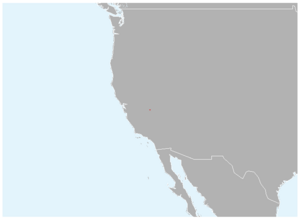Black toad facts for kids
Quick facts for kids Black toad |
|
|---|---|
 |
|
| Conservation status | |
| Scientific classification | |
 |
|
| Synonyms | |
|
Bufo exsul Myers, 1942 |
The black toad (Anaxyrus exsul) is a special kind of toad. It's also known as the Inyo toad or Deep Springs toad. This unique toad lives only in a few small wet areas. These spots are found in the Deep Springs Valley of Inyo County, California. Its original scientific name, Bufo exsul, means "exiled toad." This name fits because it lives in a tiny, isolated spot in the middle of the high desert.
About the Black Toad
The black toad has dark skin with white and tan spots. It also has a white line running down its back. This line goes from its head all the way to its rump. Adult toads are about 5 centimeters (2 inches) long.
These toads are active during warmer parts of the year. When it gets cold, they go underground. They stay near their native springs to keep warm. Unlike many other toads, this species walks instead of hopping. They also never go far from water.
Male black toads do not have vocal sacs. This means they don't make loud mating calls. Instead, they make a small chirping noise. They use this sound to mark their territory around other males. This is much like their close relative, the western toad.
Protecting the Black Toad
The black toad's home is mostly safe. However, it is still considered a vulnerable species. This is because it lives in a very small area. Even though there are many toads in their habitat, their limited range makes them vulnerable.
Deep Springs College helps care for these toads. They own much of the land where the toads live. For over a hundred years, farm animals have grazed in the toad's habitat. This grazing, along with managing plants and irrigation, might actually help the toads. It can create more open water, which is rare but good for them to breed.
The number of black toads has been quite stable. Reports from the 1970s, 1990, and 1999 showed no big changes. One group of toads was thought to have disappeared. But researchers found them again in 2003. They are now doing well where plants are kept short. In 1977, there were an estimated 80,000 toads.
The toad's main home is in streams, ditches, and marshes. These wet areas are formed by water flowing from springs. They are surrounded by cold desert land. Adult toads spend more time in water than other California toad species. They breed in shallow marsh and pond waters. In winter, they hide in animal burrows or other safe spots.
Right now, there are no major threats to these toads. But some things could cause problems in the future. These include changes in water systems or other things that affect water levels. Also, well-meaning but unscientific conservation efforts could harm them. Other risks are changes in water availability, off-road vehicles, or people collecting them. Changes in grazing and new fish that eat them could also be a problem.
Black toads like places with short plants. They also need clear access to still or slow-moving water. In recent years, some springs were fenced to keep cattle out. This caused too many plants to grow. Now, people have to cut the plants by hand. This keeps the habitat open for the toads. Despite changes in farming and grazing, the toad population has stayed quite steady for the past 20 years.
See also
 In Spanish: Anaxyrus exsul para niños
In Spanish: Anaxyrus exsul para niños


